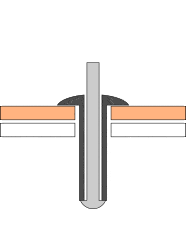This article includes a rivet sizing chart and a simple guide to help you choose the right rivet size for your needs.
Rivets are commonly used to join sheet materials like metal, plastic, wood (including beams), textiles, and leather. They are often used in aircraft construction, boat building, and aluminum and steel construction (such as heavy ironwork).
Rivets offer several advantages over standard nuts and bolts in fastening applications:
- Light weight
- Firm
- Low cost
- Easy Installation
- High Durability and Reliability
Here is how a typical Pop Rivet works:

By Heedless – Own work, CC BY-SA 4.0, Wikimedia
These are called blind rivets because they can be installed even when we can't see the other side of the sheets being fastened. They're also often called Pop Rivets because that's the sound they make as the wire is broken off the back of the rivet.
One of the most important tasks when planning to use rivets is hole preparation. The rivet hole must be prepared based on the rivet's requirements. The area that deforms is the rivet shank. We provide a rivet size chart (below) to give you the data you need to prepare a hole for all popular rivet sizes.
Rivet Sizes
Rivet sizes are:
- Imperial: Rivet diameters are measured in 1/32" increments and the lengths are measured in 1/16" increments. These values are expressed as "dash numbers". For example, a "dash 3 dash 4" means a rivet size of 3/32" diameter and 4/16" length. Rivet lengths can be measured out to half sizes (i.e. half dash numbers).
- Metric: Rivet size diameters and lengths are measured in millimeters.
How to Choose Rivet Size - Rivet Diameter and Length Calculation
The rivet shank length should be equal to the thickness of both layers you are joining plus 1.5 times the diameter of the rivet's stem. The rivet shank diameter should be equal 3 times the thickest sheet being joined. That's the minimum diameter. Choose the closest standard rivet size that is equal to or larger than those dimensions. Use the data in our rivet size chart below to help make your choice and prepare the rivet hole.
Rivet Sizing Chart: Hole Sizes & Drill Sizes
Rivet Size
- 2
- 3
- 4
- 5
- 6
- 7
- 8
- 9
- 10
- 11
- 12
- 13
Rivet Diameter (Inch)
1/16"
3/32" (0.094)
1/8" (0.125)
5/32" (0.256)
3/16" (0.188)
7/32"
1/4" (0.250)
9/32"
5/16" (0.312)
11/32"
3/8" (0.375)
13/32"
Drill Size
#51 (0.067)
#40 (0.098)
#30 (0.128)
#21 (0.159)
#11 (0.191)
#1 (0.228)
F (0.257)
L (0.290)
O (0.316)
S (0.348)
V (0.377)
Z (0.413)
Min. Hole Dia.
0.062
0.093
0.125
0.156
0.187
0.218
0.25
0.281
0.312
0.343
0.375
0.406
Max. Hole Dia.
0.072
0.103
0.135
0.171
0.202
0.233
0.265
0.2965
0.327
0.358
0.39
0.421
Be the first to know about updates at CNC Cookbook
Join our newsletter to get updates on what's next at CNC Cookbook.